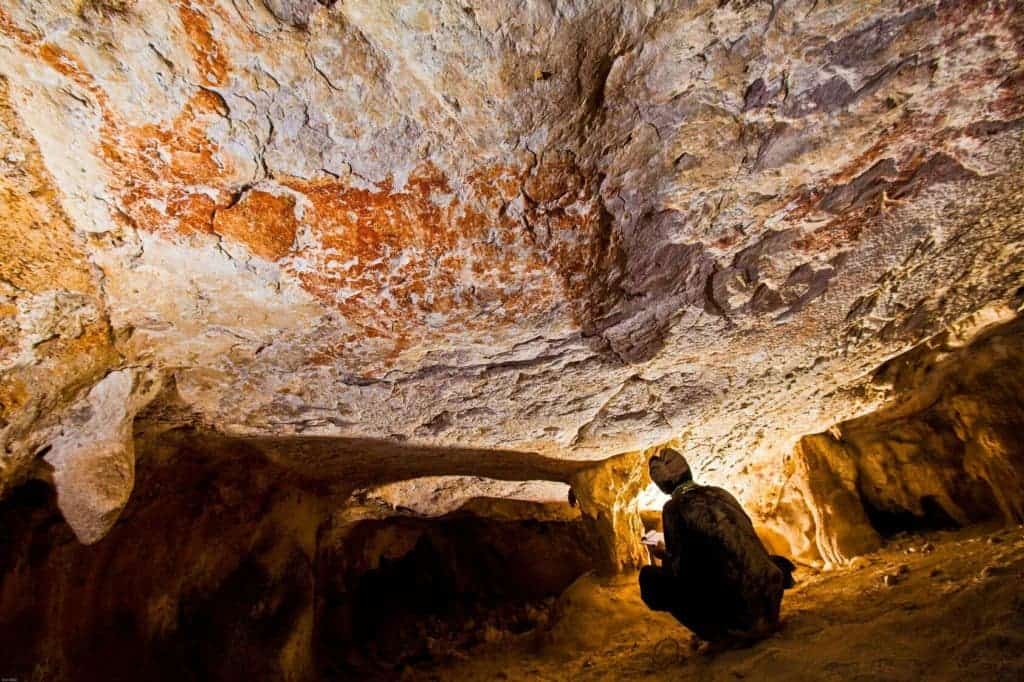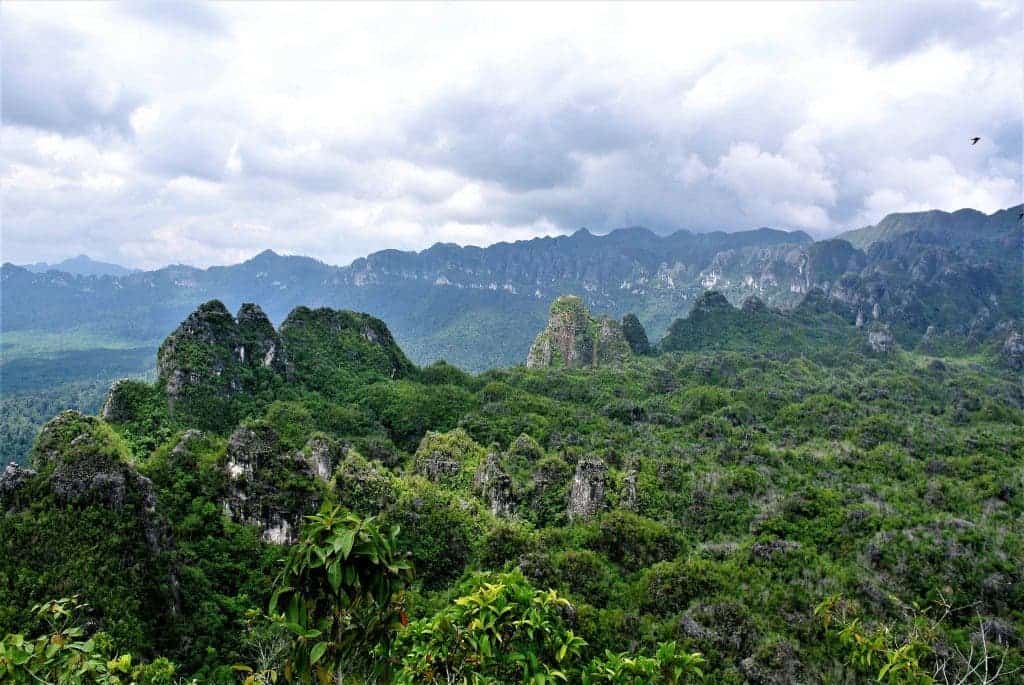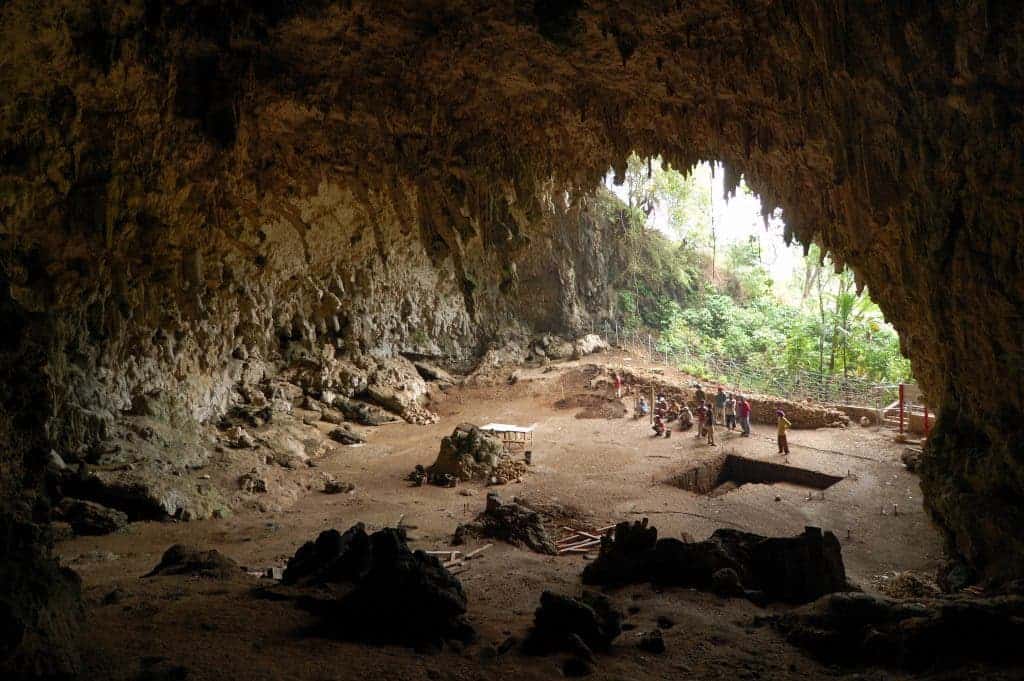A figurative painting, by definition, is a representation — an image of something else. Now, scientists have evidence that the first figurative painting was painted at least 35,000 years ago.

The first artists
Since the 1990s, thousands of rock art images have been documented in the karst caves of the East Kalimantan, a province in the Indonesian portion of Borneo. This beautiful region is remote and difficult-to-access, and contains numerous caves, some of which contain remarkable drawings made by early humans. Fifty-two rock art sites have been recorded, generally in high-level caves that contain little other evidence of human habitation. Few sites in the region have been excavated and studies remain logistically difficult.
Now, researchers have used uranium dating to show that the paintings are much older than previously thought, and probably represent the oldest figurative paintings ever found.
The prehistoric paintings and drawings include thousands of depictions of human hands (“stencils”), animals, abstract signs and symbols, and related motifs. Previously, researchers have looked at the different styles of drawing, discovering three distinct phase:
- The oldest style phase contains two different elements: large, reddish-orange-colored paintings of animals — mainly the Bornean banteng (Bos javanicus lowi), a type of wild cattle that still lives on the island — and hand stencils produced using a similar pigment;
- The second phase is dominated by purple hand stencils, many of which are partly in-filled with painted lines, dashes, dots and small abstract signs that possibly represent tattoos or other marks of social identification;
- The third phase features anthropomorphic figures, boats and geometric designs that are usually executed in black pigments.

Now, Maxime Aubert and colleagues from Griffith University studied a large, red-orange colored painting of an indeterminate animal from the first period. They used uranium dating to assess the age of the painting using a calcium carbonate sample.
[panel style=”panel-info” title=”Uranium Dating” footer=””]This is a radiometric dating technique to determine the age of calcium carbonate materials. It works by measuring the ratio between the radioactive isotope thorium-230 and its radioactive parent, uranium-234 within a sample. In the particular case of cave paintings, the difference between the type of dating can be extremely important.
“Radiocarbon dating is usually used to date the pigment layer itself, “Aubert explained. “It’s been applied in France for example to date the charcoal drawings in Chauvet cave. The problem it that it only provides a maximum age. The date is for the charcoal, not the marking event. In other words, if I walked into the cave today and pick up a 40,000 years old charcoal from the cave floor and draw an animal with it, it will date to 40,000 years.”
“The oldest cave art image we dated is a large painting of an unidentified animal, probably a species of wild cattle still found in the jungles of Borneo – this has a minimum age of around 40,000 years and is now the earliest known figurative artwork,” he added.
[/panel]
The stencil works were shown to be similar in age, suggesting that a Palaeolithic rock art tradition first appeared on Borneo between about 52,000 and 40,000 years ago.
The analysis also revealed that some 20,000 years ago, a major stylistic change happened: a new style emerged, featuring (rare) portrayals of humans. This coincided with the most extreme period of the ice age, though it’s not clear if the two events are connected.
The study also showcases another interesting parallel: previously, early cave paintings were predominantly found in Europe (particularly in today’s Spain), and they show quite a bit of resemblance to the ones found in Borneo. This suggests that a similar style evolved in at least two different populations, in very different parts of the world.

“It now seems that two early cave art provinces arose at a similar time in remote corners of Palaeolithic Eurasia: one in Europe, and one in Indonesia at the opposite end of this ice age world,” said Associate Professor Adam Brumm, a Griffith archaeologist also involved in the study.
“What’s interesting is that it coincides with the arrival of modern humans in Europe but we know that modern humans arrived in Southeast Asia between 70,000 and 60,000 years ago,” Aubert adds.
However, while we now know that humans started making figurative art at almost the same time in two different parts of the world (western Europe and Borneo), we don’t really know who these artists were.
“Who the ice age artists of Borneo were and what happened to them is a mystery,” said team co-leader Dr. Pindi Setiawan, an Indonesian archaeologist and lecturer at ITB. Setiawan has studied the art since its discovery, and, along with ARKENAS rock art expert Adhi Agus Oktaviana, leads expeditions to the Kalimantan caves. “The new findings illustrate that the story of how cave art emerged is complex,” Oktaviana said.
But Aubert says that might soon change. While no archaeological digs have been carried out quite yet, digs are indeed planned for next year. Which means that we might soon find out who these peoples were, or at least what they lived like.
“We are going back next year and we will start archaeological excavations in order to find information about these unknowns artists. We also want to date more rock art in order to refine the minimum and maximum ages for each styles and also find out how long they lasted,” Aubert concluded.
The study has been published in Nature.






